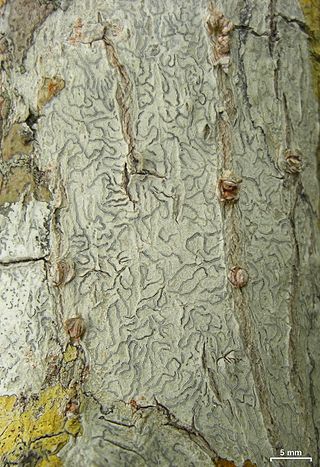Top Qs
Timeline
Chat
Perspective
Platygramme
Genus of lichen-forming fungi From Wikipedia, the free encyclopedia
Remove ads
Platygramme is a genus of lichen-forming fungi in the family Graphidaceae consisting of about 27 species.[1] The genus was circumscribed by Antoine Laurent Apollinaire Fée in 1874.[2] The type species of the genus is P. caesiopruinosa.[3] These bark-dwelling lichens are found in moist, shaded forests across tropical and warm temperate regions worldwide, where they form pale crusts that develop distinctive flattened, plate-like fruiting structures. A combination of several features characterizes Platygramme: the brown ascospores, a spore-producing layer (hymenium) speckled with granules, and elongated fruiting bodies (lirellae) with distinctive plate-like structures formed from hardened tissue.[4]
Remove ads
Description
Platygramme forms a smooth, pale grey-green to yellow-olive crust (thallus) that sits flush with the bark and lacks a true cortex. Its fruit bodies start as narrow lirellae but soon split their thalline cover and expand sideways into plate-like discs; viewed from above they look more like flattened shields than slits. A colourless to faintly brown excipulum lines the disc, and the exposed surface may carry a thin whitish pruina. The clear hymenium is non-inspersed, while the thin-walled, Graphis-type asci usually contain eight hyaline ascospores that become distinctly muriform—divided by a lattice of transverse and longitudinal septa—yet remain iodine-negative (I–). Most species are chemically inert or produce only traces of stictic acid-series depsidones.[5]
The plate-forming discs separate Platygramme from script lichens with permanent slits such as Glyphis and Hemithecium. Unlike Chapsa, whose discs are star-shaped with radiating lobules, Platygramme displays entire, rounded plates; and in contrast to Kalbographa, it lacks vividly coloured anthraquinone pigments and its margins remain pale or only lightly carbonised (blackened).[5]
Remove ads
Habitat and distribution
The genus is pantropical to warm-temperate in distribution. All known species are bark-dwelling (corticolous), occupying shaded boles and large branches in moist evergreen forests from lowland Amazonia and West-Central Africa to Southeast Asia and northern Australia. Although tolerant of brief sunflecks, they disappear quickly when canopy cover is removed; their presence therefore signals long-established, relatively undisturbed woodland with high ambient humidity.[5]
Remove ads
Species
Summarize
Perspective
As of June 2025[update], Species Fungorum (as listed in the Catalogue of Life) accepts 27 species of Platygramme.[6]
- Platygramme arechavaletae (Müll.Arg.) A.W.Archer (2005)[7]
- Platygramme australiensis Staiger (2002)[8]
- Platygramme coccinea Seavey & J.Seavey (2014)[9]
- Platygramme colubrosa (Nyl.) Staiger (2002)[8]
- Platygramme commutabilis (Kremp.) A.W.Archer (2009)
- Platygramme computata (Kremp.) A.W.Archer (2007)
- Platygramme discurrens (Nyl.) Staiger (2002)[8]
- Platygramme elaeoplaca (Zahlbr.) Z.F.Jia & Lücking (2017)
- Platygramme elegantula Seavey & J.Seavey (2017)[10]
- Platygramme fuscescens A.W.Archer (2005)[7] – Australia
- Platygramme hainanensis Z.F.Jia & Kalb (2012)[11] – China
- Platygramme impudica (A.W.Archer) A.W.Archer (2005)[7]
- Platygramme kaalensis (Tuck.) Luch & Lücking (2018)[12]
- Platygramme lueckingii Z.F.Jia & Kalb (2012)[11] – China
- Platygramme microspora Sutjar. & Kalb (2014)[13]
- Platygramme muelleri (A.W.Archer) Staiger (2002)[8]
- Platygramme pachyspora (Redinger) Staiger (2002)[8]
- Platygramme pachnodes (Fée) Fée (1874)
- Platygramme platyloma (Müll.Arg.) M.Nakan. & Kashiw. (2003)[14]
- Platygramme praestans (Müll.Arg.) Staiger (2002)[8]
- Platygramme pseudomontagnei (M.Nakan.) M.Nakan. & Kashiw. (2003)[14]
- Platygramme pudica (Mont. & Bosch) M.Nakan. & Kashiw. (2003)[14]
- Platygramme subarechavaletae Poengs. & Kalb (2014)[15] – Thailand
- Platygramme subcolubrosa J.Kalb & Kalb (2017)[16] – Thailand
- Platygramme taiwanensis (J.C.Wei) Z.F.Jia & Lücking (2017)[17]
- Platygramme tumulata (Nyl.) Luch & Lücking (2018)[12]
- Platygramme unirana M.Cáceres, Aptroot & Lücking (2014)[18] – Brazil
- Platygramme wattiana (Müll.Arg.) V.P.Tewari & Upreti (2008)
References
Wikiwand - on
Seamless Wikipedia browsing. On steroids.
Remove ads

